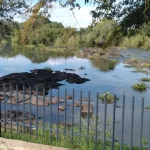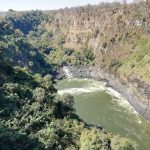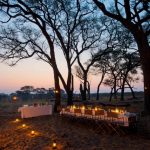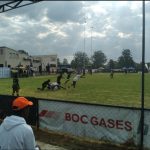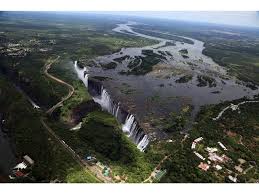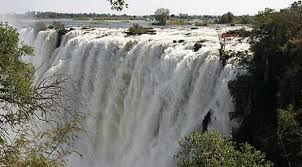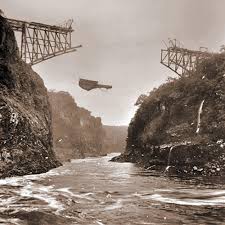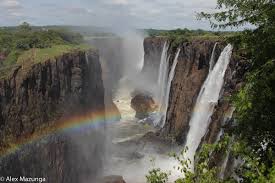
The Victoria Falls also as known as Mosi-oa-Tunya, “The Smoke That Thunders” and Toka Leya – Shungu Namutitima, “Boiling water” and proudly my namesake is a waterfall on the Zambezi River found in the southern corner of Africa, the area provides habitat for a wide variety of unique species those being plants and animals. Guess what….It is located on the border between Zambia and Zimbabwe yes another common factor between the two countries and is considered to be one of the world’s largest waterfall due to its width of 1,708 metres (5,604 ft). Discovered by yours truly David Livingston back in the 1800s. The Scottish missionary and explorer, is believed to have been the first European to view Victoria Falls on the 16th of November 1855, from what is now known as Livingstone Island, one of two land masses in the middle of the river, immediately upstream from the falls near the Zambian shore. Mr Livingstone named his sighting in honor of Queen Victoria of Britain, but the Sotho language name, Mosi-oa-Tunya—”The Smoke That Thunders”—continues in common usage. Some of Livingstone’s porters were Sothos who gave the name Mosi-oa-Tunya. Coincidentally, a group of Sothos migrated to an area near the falls, and went on to form part of modern day Lozi tribe. The World Heritage List officially recognises both names.Livingstone also cited an older name, Seongo or Chongwe, which means “The Place of the Rainbow”, as a result of the constant spray.
The nearby national park in Zambia is named Mosi-oa-Tunya, whereas the national park and town on the Zimbabwean shore are both named Victoria Falls.Early Stone Age Acheulean stone artifacts and Oldowan tools were excavated at archaeological sites around the falls, as well as Sangoan tools and Lupemban artifacts dating to the Middle Stone Age.Early Iron Age pottery was excavated at a vlei site near Masuma Dam in the early 1960s.Evidence for iron smelting was also found in a settlement dated to the late 1st millennium AD.The southern Tonga people known as the Batoka/Tokalea called the falls Shungu na mutitima. The Matabele, later arrivals, named them aManz’ aThunqayo, and the Batswanaand Makololo (whose language is used by the Lozi people) call them Mosi-o-Tunya. All these names mean essentially “the smoke that thunders”.A map drawn by Nicolas de Fer in 1715 shows the fall clearly marked in the correct position. It also shows dotted lines denoting trade routes that David Livingstone followed 140 years later.[citation needed] A map from c. 1750 drawn by Jacques Nicolas Bellin for Abbé Antoine François Prevost d’Exiles marks the falls as “cataractes” and notes a settlement to the north of the Zambezi as being friendly with the Portuguese at the time.
In November 1855, David Livingstone was the first European who saw the falls, when he traveled from the upper Zambezi to the mouth of the river between 1852 and 1856. The falls were well known to local tribes, and Voortrekker hunters may have known of them, as may the Arabs under a name equivalent to “the end of the world”. Europeans were sceptical of their reports, perhaps thinking that the lack of mountains and valleys on the plateau made a large falls unlikely.Livingstone had been told about the falls before he reached them from upriver and was paddled across to a small island that now bears the name Livingstone Island in Zambia. Livingstone had previously been impressed by the Ngonye Falls further upstream, but founde new falls much more impressive, and gave them their English name in honour of Queen Victoria. He wrote of the falls, “No one can imagine the beauty of the view from anything witnessed in England. It had never been seen before by European eyes; but scenes so lovely must have been gazed upon by angels in their flight.”
In 1860, Livingstone returned to the area and made a detailed study of the falls with John Kirk. Other early European visitors included Portuguese explorer Serpa Pinto, Czechexplorer Emil Holub, who made the first detailed plan of the falls and its surroundings in 1875 (published in 1880),and British artist Thomas Baines, who executed some of the earliest paintings of the falls. Until the area was opened up by the building of the railwayEuropean settlement of the Victoria Falls area started around 1900 in response to the desire of Cecil Rhodes’ British South Africa Companyfor mineral rights and imperial rule north of the Zambezi, and the exploitation of other natural resources such as timber forests north-east of the falls, and ivory and animal skins. Before 1905, the river was crossed above the falls at the Old Drift, by dugout canoe or a barge towed across with a steel cable.Rhodes’ vision of a Cape-Cairo railway drove plans for the first bridge across the Zambezi. He insisted it be built where the spray from the falls would fall on passing trains, so the site at the Second Gorge was chosen. See the main article Victoria Falls Bridge for details.From 1905 the railway offered accessible travel from as far as the Cape in the south and from 1909, as far as the Belgian Congo in the north. In 1904 the Victoria Falls Hotel was opened to accommodate visitors arriving on the new railway. The falls became an increasingly popular attraction during British colonial rule of Northern Rhodesia (Zambia) and Southern Rhodesia (Zimbabwe), with the town of Victoria Falls becoming the main tourist centre.
In 1964, Northern Rhodesia became the independent state of Zambia. The following year, Rhodesia unilaterally declared independence. This was not recognized by Zambia, the United Kingdom nor the vast majority of states and led to United Nations-mandated sanctions. In response to the emerging crisis, in 1966 Zambia restricted or stopped border crossings; it did not re-open the border completely until 1980. Guerrilla warfare arose on the southern side of the Zambezi from 1972: the Rhodesian Bush War. Visitor numbers began to drop, particularly on the Rhodesian side. The war affected Zambia through military incursions, causing the latter to impose security measures including the stationing of soldiers to restrict access to the gorges and some parts of the fallsZimbabwe’s internationally recognised independence in 1980 brought comparative peace, and the 1980s witnessed renewed levels of tourism and the development of the region as a centre for adventure sports. Activities that gained popularity in the area include whitewater rafting in the gorges, bungee jumping from the bridge, game fishing, horse riding, kayaking, and flights over the falls.
The_tourist
